Digital Transformation: Technologies, Steps & Use Cases in 2024
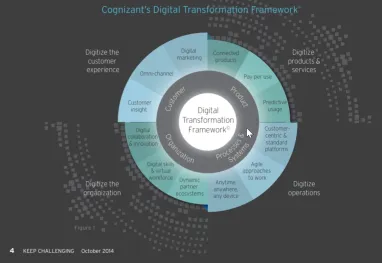
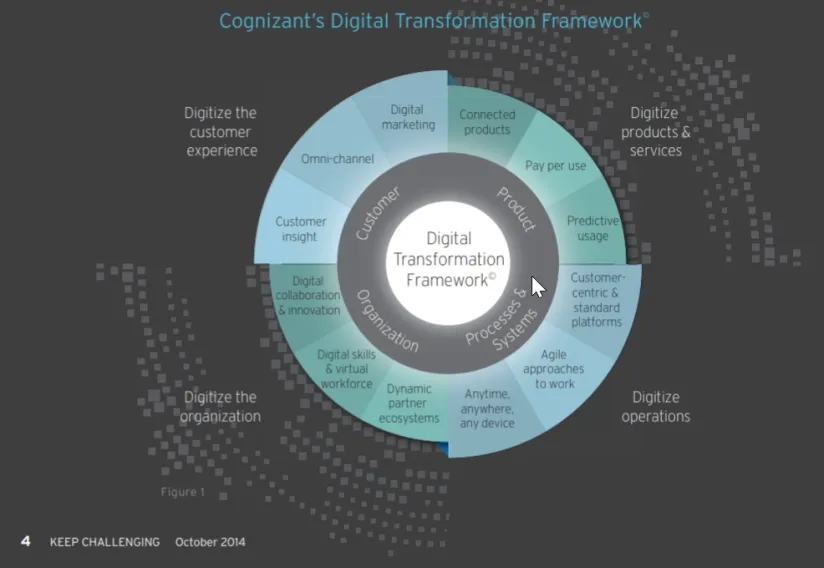
With the rise of personal computers in the 1980s, companies started going through digital transformations (DX) to improve their products/services and reduce costs. Yet, as of 2021, the adoption of DX has risen up to another level due to the negative impact of the pandemic on performing tasks manually.
However, according to McKinsey, less than 30 percent of DX processes are success stories. Success can be achieved via company-wide alignment, design thinking, and the adoption of leading-edge technologies. In this article, we introduce a roadmap that helps to create success stories.1
What is digital transformation?
Let’s start with our digital transformation definition:
Digital transformation is the process of integrating digital technologies into all aspects of a business to meet the market and changing business requirements.
It aims to increase the effectiveness of business operations and customer relations. To achieve these goals, organizations need to update their systems, processes, organizations, and culture.
Why does it matter now?
Competition is increasing and DX is powerful leverage for companies that aim to stay relevant. As our research indicates below, today, 89% of companies have already adopted a digital-first business strategy and the DX market is expected to grow at a CAGR of 23% until 2025.
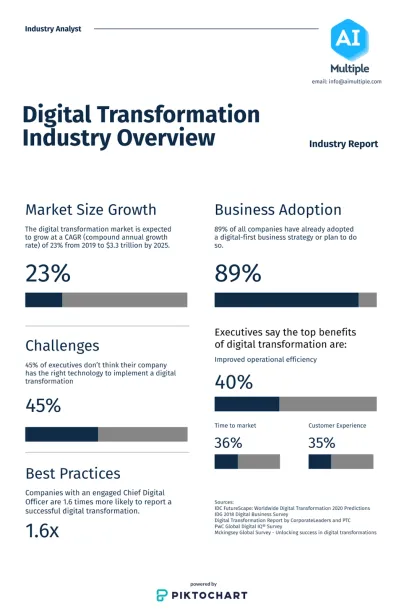
How did the pandemic affect the digital transformation efforts of companies?
The influence of the pandemic on businesses has been harsh. According to a PwC survey, over 50% of companies in the US are either deferring or canceling their planned investments due to the pandemic. However, the IDC study highlights that businesses are not deferring or canceling their DX investments. Despite the pandemic, global spending on DX technologies and services was estimated to grow 10% in 2020 to $1.3 trillion. Gartner forecasts global IT spending to grow 9% in 2021 as businesses are more intentional in their DX efforts. Google Trends data also shows that people’s interest in DX has increased over time.
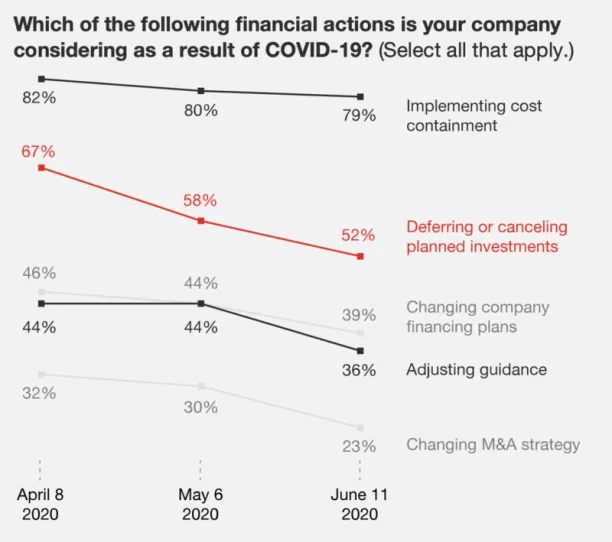
Source: PWC
What are the steps to digital transformation?
Successful DX requires a well-designed framework that will guide you through your DX journey. This framework is our roadmap to digital transformation success. However, if you want to see more frameworks from different consulting companies, you can check out this article where we explained our framework comprehensively and listed five other frameworks.
1. Identify digital transformation objectives
Determine the organization’s level of digitization and try to align the current state and long-term digital goals. Each organization, with different needs, has a slightly different set of transition targets, but this is a crucial step toward organizational synergy. The figure below is BCG’s digital maturity model which may be helpful to identify an organization’s level of digitization.
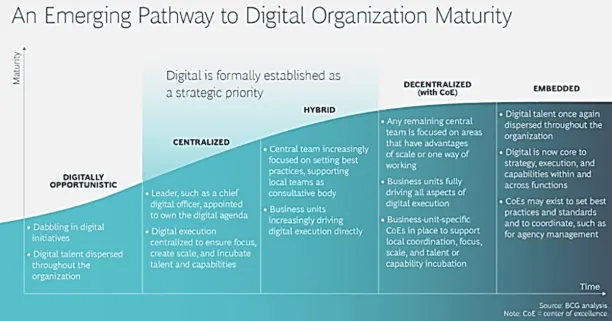
Source: BCG Analysis
To learn more, check out our comprehensive article on digital maturity
2. Formulate a digital transformation strategy
Technology investments should serve the business, not spend money because it’s trendy. In this regard, building a feasible game plan by selecting areas of improvement and starting to integrate digital systems from those areas. The organization’s objectives should be a step-by-step process and business may fail because of actions taken with haste.
3. Decide on the necessary technology enablers
Enablers such as automation, analytics, machine learning, cloud, IoT, outsourcing and process mining can be vital drivers for a successful DX. Organizations should research and decide which enablers would be the best fit for the organization since these enablers can not generate benefits in every situation. For example:
- Outsourcing can improve an organization’s focus while reducing the cost base. However, companies need to consider potential outsourcing challenges such as data security and licensing.
- Automation should be a part of every DX but automating poorly understood processes can lead to operational issues. Firms can leverage process mining to gather in-depth information about their processes.
4. Establish competent technology leadership
Without leadership support, change management tends to be unsuccessful. Having a correct corporate governance system that ensures the effective division of tasks, a company can increase its chances of success:
- CIO Office: Assembles the necessary teams, ensures coordination between them, and monitors every step of the DX by determining relevant KPIs.
- Line of business leaders: Responsible for executing tasks determined by the CIO with a given budget.
- Digital transformation council: Provides the necessary communication between the line of business leaders and the CIO. The division managers lay out their requirements to be successful for the task at hand. The most important function of such a council would be to set the budget and allocate it among the line of business leaders.
5. Train the staff and integrate a digital culture among the organization
With the culture and education you provide across the organization, staff adapts to change easier and each process in the firm is operating agile. Without cultural change, the company could miss the next technology revolution and require another significant transformation effort to catch up. These requirements lead to the question: “What kind of cultural attributes the organization needs for a successful DX?”. We have seen three major cultural changes for the companies that achieved DX:
- The organization is better connected and responsive across departments so that employees return quickly to changing customers’ needs.
- Employees are encouraged to solve problems.
- Employees are ready to take risks, and if a risky action causes a breakdown, they are willing to learn from the failure.
To learn more about enabler culture and ways to build such culture, you can read our article Organizational Culture: Core Piece of Digital Transformation.
Digital transformation trends
It is vital to stay ahead of the technology curve. Having the knowledge of digital transformation trends can help executives in making better decisions regarding digital investments. We identified automation testing, AI, cybersecurity, faster connectivity, enterprise automation & RPA as among the major trends that will shape business outcomes.
What are some digital transformation case studies?
Case studies can help executives understand the benefits of complex topics and inspire them to take new actions. As a result, we’ll go over two digital transformation case studies. To find out more case studies, you can read our 31 Digital Transformation Case Studies and Success Stories article.
Audi city
Audi city, the virtual showroom effort of the German automaker Audi, was launched in 2012. By using tablets and power walls, Audi introduces its product catalog to the customers in the big city centers where it is costly to open traditional showrooms. Each Audi city has specially trained employees that expose potential customers to Audi cars and advise them based on their needs and budget. Audi increased its sales by 60% in some locations as a result of the program.
Unilever
A well-known approach for boosting revenue is to penetrate new markets/segments by establishing new brands. Brand creation, on the other hand, takes time because it necessitates data and analysis of consumer behavior. Data analytics and machine learning algorithms, on the other hand, can reduce the amount of time required for analysis. In 2018, Unilever launched ten new brands by analyzing the market with ML. The use of ML models reduces the time required for launch up to 50% compared to the pre-digital transformation launches.
What value does digital transformation propose to industries?
Healthcare links
These are the main players in the healthcare industry and DX proposes different benefits to each player:
- Healthcare providers/Hospitals: DX can lead to improved patient care thanks to digital technologies that assist doctors while reducing operating costs.
- MedTech / health tech companies: These companies are technology providers and they enable DX and serve digitally savvy companies. Increased DX increases their addressable market.
- Pharma companies: Digital technologies that enable them to collect and share data for research purposes and facilitate personalized care.
For more information on digital transformation in the healthcare industry, feel free to check our article. You can also check our article on digital transformation for pharmaceuticals.
Retail
Retailers focus on three aspects of transformation:
- Customer experience: Customer experience is the key factor for a business to differentiate itself from its competitors.
- Enterprise agility is at its heart, launching Minimum Viable Products (MVPs) with quick decision making and iteration.
- Operational cost reduction: With analytics, businesses can reduce their operational costs such as supply chain.
For more information on digital transformation in retail, feel free to check our related article.
Banking
DX offers banks automation opportunities and digital banking products that enable secure and frictionless customer journeys. fraud detection, compliance For more information on digital transformation in banking, feel free to check our article.
Real Estate
Digital technologies are evolving the real estate industry via services such as virtual tours, automated transactions, and personalized services that can enhance the home buying experience while automating tedious tasks for real estate agents. For more information on digital transformation in real estate, feel free to check our article.
Insurance
With digital technologies, insurers can automate tasks such as claim processing and fraud detection so that they can focus on developing customer-centric products. For more information, you can check our Top Insurtech Trends & Technologies: In-depth Guide and digital transformation in insurance articles.
Professional Services/ Consulting
DX has fundamentally changed the consulting landscape. New players such as Accenture entered the market in the 90s have grown far beyond traditional management consulting companies such as McKinsey and BCG. As a result, traditional consultancies are playing the catchup game, buying digital-focused companies, launching digital/AI-focused divisions, and remarketing themselves as tech/digital consultancy companies. For more information on how digital & AI is evolving consulting, you can check out our articles below:
How do I learn more?
Solution providers and consultants organize numerous DX events so DX professionals from different companies can network and learn from one another’s experiences. You can check out DX conferences to join.
If you are ready to start your DX journey, you can check our data-driven and comprehensive list of digital transformation consultant companies.
You can also check our other articles on DX:
- Top 7 Digital Transformation Best Practices for the Organizations
- Top 10 Digital Transformation KPIs to Track Your Digital Evolution
- Digital transformation: 31 Case Studies and Success Stories
- 5 Digital Transformation Trends
If you have further questions please do not hesitate to contact us:
External Links
- 1. Unlocking success in digital transformations, McKinsey. Accessed 2 January, 2024

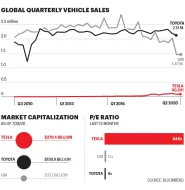

Comments
Your email address will not be published. All fields are required.